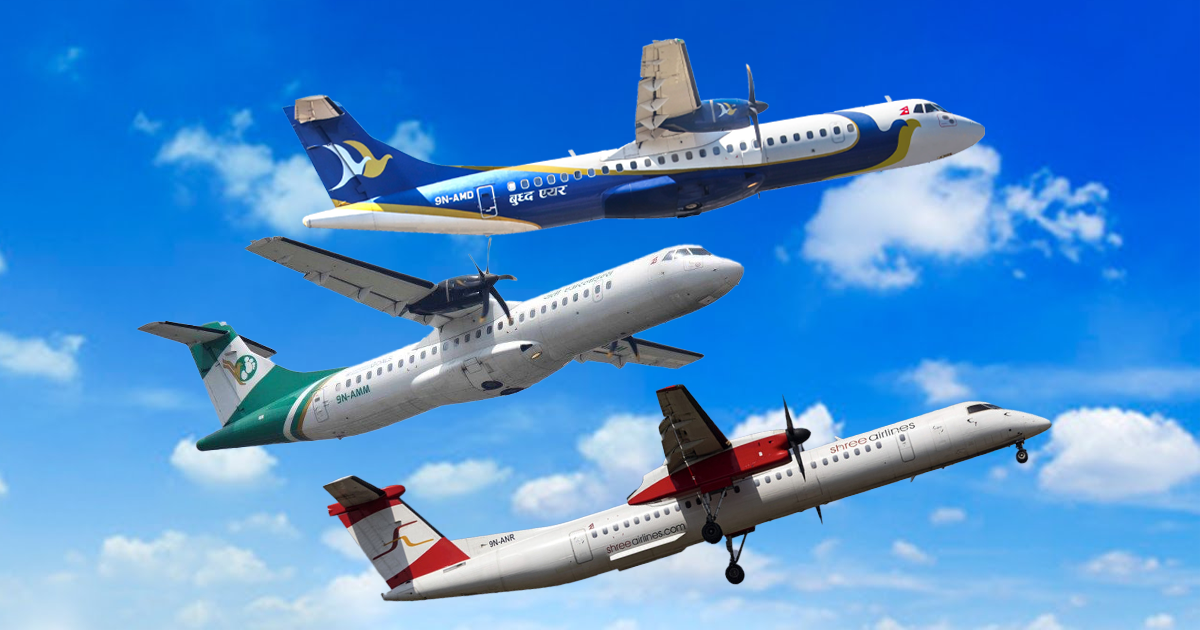Kathmandu: For more than two and a half decades, Buddha Air, Yeti Airlines, and the recently emerging Shree Airlines have been competing to provide passenger services in Nepal’s domestic aviation market.
Although over a dozen airlines have obtained permission for domestic flights, many have failed to compete effectively and disappeared within a short time.
Due to their inability to compete in the market and to operate modern aircraft that attract passengers, almost all airlines that tried to challenge Buddha and Yeti in the past 27 years have collapsed midway.
In the last two decades, around 50 airlines were registered in total, but only nine have remained in regular operation. Among them, Saurya Airlines and Guna Airlines have already suspended their services, while Nepal Airlines is managing domestic flights with only two Twin Otter aircraft.
Nepal Airlines struggles to maintain regular flights due to frequent technical problems with its aircraft, making it difficult to even operate one flight consistently. Private airlines seem to be benefiting from the national carrier’s weakness. In fact, the government has shown little intention of strengthening the national flag carrier.
The government, run on commissions and influenced by middlemen, often allows companies to enter the market with weak business strategies, resulting in the airline’s near collapse. Instead of adding aircraft that could compete with private airlines, the government brought in six Chinese aircraft that proved unfit for operation — a clear act of negligence. Those planes are still parked at Tribhuvan International Airport, collecting dust, while Nepal Airlines’ debt burden continues to grow each year.
Among domestic airlines, Sita, Summit, and Tara Air focus on flights to remote areas, and thus do not compete on trunk routes serving urban airports. Buddha Air has established a strong presence in city airports by offering modern aircraft and superior passenger services.
Yeti Airlines, using state-of-the-art ATR 72 aircraft, has emerged as Buddha Air’s main rival. Recently, Shree Airlines has entered the scene with different types of aircraft and created its own market, posing a challenge to both Buddha and Yeti. Including its helicopters, Shree Airlines now operates around 15 aircraft, though its market share still lags behind the two leading carriers.
Frequent aircraft accidents, the shrinking fleet size, and the inability of airlines to replenish or upgrade their aircraft have further weakened the overall domestic aviation industry.
Although there are nine fixed-wing airlines in regular operation, 12 other companies provide services as helicopter operators. These include Air Dynasty, Altitude, Annapurna, Fishtail, Heli Everest, Kailash, Manang, Mountain, Prabhu, Shree, Simrik, and Mustang Helicopters.
Among them, Mustang Helicopters has been grounded for nearly three years due to failure to meet minimum operational requirements set by the Civil Aviation Authority of Nepal (CAAN). Other helicopter companies operate two or three helicopters each, but many are on the verge of closure.
Around a dozen airlines are registered with the Ministry of Culture, Tourism and Civil Aviation but have vanished before obtaining approval from the Civil Aviation Authority. This means that although they get permission from the Tourism Ministry, they fail to complete the required procedures to receive the Air Operator’s Certificate (AOC) from CAAN — without which no domestic airline can begin operations.
According to CAAN spokesperson Gyanendra Bhul, more than half a dozen airlines are currently in the process of obtaining flight permits. These include both helicopter and fixed-wing operators. However, several airlines aspiring to operate international flights have also failed to meet CAAN’s standards and have not been granted approval.
Even airlines that receive permission often operate only briefly, introducing one or two aircraft and adopting aggressive strategies — but their market presence remains weak. Many fail to achieve results aligned with their strategies, leading to their early collapse.
In the current fiscal year 2025/26, several new airlines — Heli Air Nepal, Sagarmatha Heli, Gaganchumbhi Heli, Danfe Air, Guna Air, and Sumedha Air — are advancing through various stages of the approval process. Previously, RS Helicopter, Shivam Helicopter, Sagarmatha Helicopter, and Dhaulagiri Helicopter had also applied during the last fiscal year 2024/25, but none have yet been established as operational airlines.
CAAN says airlines that fail to complete the required procedures according to set standards will not receive permission. These companies are at various stages of waiting for their AOC approval. Bhul noted that obtaining permission from the ministry alone is not enough — airlines must also meet all aviation safety and operational standards and have the technical capacity to fly.
According to the Civil Aviation Authority, most airlines enter the sector without proper preparation or long-term investment strategies, often driven by impulsive motives. Many fail to sustain operations due to financial constraints and are forced to shut down.
Frequent aircraft accidents, the shrinking fleet size, and the inability of airlines to replenish or upgrade their aircraft have further weakened the overall domestic aviation industry. Many airlines rush to enter the market but fail to develop sustainable business models or secure adequate financial backing — the key reasons behind the repeated rise and fall of domestic airlines in Nepal.



Comment Here